Resumo
A presente intervenção visa discutir as relações entre Estados Unidos e China na Ásia-Pacífico e irá discorrer sobre a entrada dos Estados Unidos nas negociações da Trans-Pacific Partnership (TPP), em 2008. A complexa relação entre esses países faz necessária a discussão acerca sua interdependência econômica, as estratégias chinesas para a política internacional e as participações norte-americanas nos tratados de livre-comércio que abrangem a região. O foco da discussão na Parceria Trans-Pacífico se deve por esta se apresentar em muitos momentos, como o elemento chave na estratégica da administração Obama no objetivo de aprofundar o envolvimento norte americano na região do Pacífico. Os crescentes mercados na Ásia Pacífico já são os principais destinos para os produtos manufaturados dos Estados Unidos e estima-se que o grupo de países participantes do TTP é um mercado de grande significância para exportação de bens e serviços dos Estados Unidos. Assim, tem-se um panorama das perspectivas que podem ser aguardadas para as relações sino-americanas nos próximos anos.Referências
ACUERDOS COMERCIALES DEL PERU. Alianza del Pacífico. Disponível em<http://www.acuerdoscomerciales.gob.pe/index.phpoption=com_content&view=category&layout=blog&id=166&Itemid=185>. Acesso em: 02/12/2012.
ARMSTRONG, Shiro. Australia and the Future of the Trans –Pacific Partnership Agreement. In: Eaber Working Paper Series. East Asian Bureau of Economic Research:Beijing, 2011. Paper no 71.
ASSOCIATION OF SOUTHEAST ASEAN NATIONS. ASEAN Free Trade Area (AFTA Council). Disponível em <http://www.asean.org/communities/asean- economic-community/category/asean-free-trade-area-afta-council>. Acesso em: 05/12/2012.
AUSTRALIAN GOVERNMENT: Department of Foreign Affairs and Trade. Disponível em <http://www.dfta.gov.au/fta/rcep/downloads/rcep-background- paper-background.pdf>. Acesso em: 14/11/2012.
CARVALHO, Cecília; CATERMOL, Fabrício. As relações econômicas entre China e EUA: Resgate histórico e implicações. Revista do BNDES, Rio de Janeiro, v. 16, n. 31, p. 215-252. Junho, 2009.
CBC NEWS: What is the Trans-Pacific Partnership? Disponível em <http://www.cbc.ca/news/world/story/2012/06/20/f-trans pacificpartnership- explained.html>. Acesso em: 28/11/2012.
CHANG, Gordon. China Is 175.6% Dependent on the U.S. Disponível em: <http://www.forbes.com/sites/gordonchang/2012/01/22/china-is-175-6- dependent-on-the-u-s/>. Acesso em: 10/12/2012.
CHINA DAILY. The benefits of an FTAfor Asia. Disponível em <http://www.usa.chinadaily.com.cn/opinion/201212/13/content_16012372.htm>. Acesso em: 10/12/2012.
CHINA’S PEACEFUL DEVELOPMENT ROAD. 2005. Disponível em <http://www.china.org.cn/english/features/book/152684.htm>. Acesso em: 05/03/2012.
CLINTON, Hillary. 2011. Disponível <http://www.foreignpolicy.com/articles/2011/10/11/americas_pacific_century>. Acesso em: 27/11/ 2012.
EAST ASIA FORUM: China ́s participation in the Trans –Pacific Partnership. Disponível em: <http://www.eastasiaforum.org/2011/12/11/china-participation- in-the-trans-pacificpartnership/>. Acesso em: 21/11/2012.
EAST ASIA FORUM: US Commits to ASEAN Integration. Disponível em <http://www.eastasiaforum.org/2012/11/25/us-commits-toasean-integration/>. Acesso em: 27/11/2012.
EXPORT.GOV. The North American Free Trade Agreement (NAFTA). Disponível em: <http://export.gov/FTA/nafta/index.asp>. Acesso em: 03/12/2012.
FERGUSSON, Ian; VAUGHN, Bruce. The Trans-Pacific Partnership Agreement. Washington DC: Congressional Research Service. December 12, 2011. R40502. Disponível em: . Acesso em: 29/11/2012.
FOREIGN AFFAIRS: The Trans- Pacific Partnership and the Rise of China. Disponível em <http://www.foreignaffairs.com/articles/136647/bernard-k- gordon/the-trans-pacific-partnership-and-the-rise-of-china>. Acesso em: 14/11/2012.
GLASER, B. S. and Medeiros, E. S. The Changing Ecology of Foreign Policy-Making in China: The Ascension and Demise of the Theory of “Peaceful Rise”. The China Quarterly, 190, June 2007, p.291-310.
KISSINGER, Henry. Diplomacia. Editora Gradiva. 3a Edição. Lisboa, 2007.
LI, Chunding; WAHLLEY, John. China and the TPP: A numerical Simulation Assessment of the Effects Involved. NBER Working Paper Series. Cambridge, May 2012.Working Paper 18090. Disponível em: < http://www.nber.org/papers/w18090>. Acesso em: 28/11/2012.
MOHAN, C. R. China’s “Peaceful Rise”: The Ryme of the Ancient Mariner. Economic and Political Weekly. Vol. 39. No. 33, p. 3.669-3.702, 2004. Disponível em:< http://www.jstor.org/pss/4415413>. Acesso em: 11/11/2012.
MORRISON, Wayne M. China-US Trade Issues. CRS Report for Congress. Congressional Research Service. Maio, 2012. Disponível em: <http://www.fas.org/sgp/crs/row/RL33536.pdf>. Acesso em: 12/11/2012.
NEW YORK DAILY NEWS. Obama visits Asia for first international trip since reelection. Disponível em:<http://www.nydailynews.com/news/politics/obama- swing-asia-reelection-article 1.1203693>. Acesso em: 20/11/2012.
NIXON, Richard. OFFICE OF THE UNITED STATES TRADE REPRESENTATIVE. Trans-Pacific Partnership Announcement. Disponível em: <http://www.ustr.gov/about-us/press- office/press- releases/2009/december/trans-pacific-partnership-announcement>. Acesso em: 02/12/2012.
OFFICE OF THE UNITED STATES TRADE REPRESENTATIVE. U.S. – Korea Free Trade Agreement: New Oportunities for U.S. Exporters Under the U.S. –Korea Trade Agreement. Disponível em: <http://www.ustr.gov/trade-agreements/free- trade-agreements/korus-fta>. Acesso em: 20/10/2012.
OFFICE OF THE UNITED STATES TRADE REPRESENTATIVE. Outlines of the Trans- Pacific Partnership Agreement. Disponível em: <http://www.ustr.gov/about-us/press-office/fact sheets/2011/november/outlines- trans-pacific-partnership-agreement>. Acesso em: 20/10/2012.
Joint Communique of the People's Republic of China and the United States of America. Shangai. Fevereiro, 1972. Disponível em: <http://www.china.org.cn/world/china_us_facts_2011/2011- 07/11/content_22966711.htm> Acesso em: 15/12/2012.
SHIJIAN, Zhou. China-US economic relations: accords and discords. 27 de fevereiro de 2012. Disponível em: <http://www.china.org.cn/opinion/2012- 02/27/content_24744473.htm> Acesso em: 15/12/2012.
SOUTH ASIAN ASSOCIATION FOR REGIONAL COOPERATION. South Asian Free Trade Area: Disponível em: <http://www.saarc- sec.org/areaofcooperation/detail.php?activity_id=5>. Acesso em: 02/12/2012.
SUETTINGGER, R.L. The Rise and Descent of “Peaceful Rise”. China Leadershio Monitor. Número 12. 2005. Disponível em <http://weblog.leidenuniv.nl/media/blogs/76061/kijkennaardepers/archives/zheng%20bijian.pdf>. Acesso em: 14/10/2012.
THE JAPAN TIMES ON LINE: TPP: APEC ́s anti- China son? Disponível em <http://www.japantimes.co.jp/text/eo20111130gc.html>. Acesso em: 10/11/2012.
THE UNITED STATES PATENT AND TRADEMARK OFFICE (USPTO). Filing a New International Application – United States Patent and Trademark Office. Disponível em . Acesso em: 13/11/2012.
THE WHITE HOUSE. Fact Sheet: The U.S. –ASEAN Expanded Economic Engagement (E3) Initiative. Disponível em: . Acesso em: 22/11/2012.
THORTON, J.L. China’s Peaceful Rise: Speeches of Zheng Bijian 1997-2004. Disponível em <http://www.brookings.edu/fp/events/20050616bijianlunch.pdf>. Acesso em: 12/11/2012.
UNITED NATIONS ESCAP. About ESCAP. Disponível em: <http://www.unescap.org/about/>. Acesso em: 04/12/2012.
UNITED NATIONS ESCAP. The Asia-Pacific Trade Agrement: Disponível em <http://www.unescap.org/tid/apta.asp>. Acesso em: 03/12/2012.
U.S. AGENCY FOR INTERNATIONAL DEVELOPMENT. Disponível em: <http://www.usaid.gov/>. Acesso em: 11/12/2012.
VIZENTINI, Paulo. Introdução: O sistema mundial entre a uni e a multipolaridade. In_Neohegemonia Americana ou multipolaridade? Polos de poder e sistema internacional. Ed.UFRGS. Porto Alegre, 2006.
WANG, Jisi. “Peaceful Rise”: a discourse in China. Pekin University. 2006. Disponível em: <http://www2.lse.ac.uk/newsAndMedia/news/archives/2006/Wang_Jisi.aspx>. Acesso em: 09/12/2012.
WESSEL, David. For Both Nations, Depending on a Rival. Disponível em: http://online.wsj.com/article/SB100014240527487034316045755224833949509 38.html. Acesso em: 20/12/2012.
WALL STREET JOURNAL. Huawei Fires Back at the U.S. 08/10/2012. Disponível em: <http://online.wsj.com/article/SB10000872396390443982904578044190738613 734.html.>. Acesso em: 20/12/2012.
WORLD TRADE ORGANIZATION. Agreement on Trade-Related Aspects of Intellectual Property Rights. Disponível em: <http://www.wto.org/english/tratop_e/trips_e/t_agm0_e.htm>. Acesso em: 26/11/2012.
ZHENG Bijian. IN: THORTON, J.L. China’s Peaceful Rise: Speeches of Zheng Bijian 1997-2004. 2003. Disponível em: <http://www.brookings.edu/fp/events/20050616bijianlunch.pdf>. Acesso em: 12/11/2012.

Este trabalho está licenciado sob uma licença Creative Commons Attribution 4.0 International License.
Copyright (c) 2013 Revista Aurora





